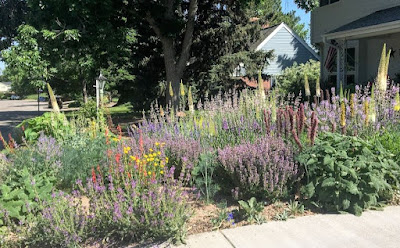Posted by: John Murgel, Horticulture and Natural Resources Agent, Douglas County
Looking for some green in your life, but concerned about
landscape water use? Then let me tell
you about extremely dry gardens. Gardens
without supplemental water.
 |
| Desert Marigold (yellow, front) growing happily in Southern Arizona without water. It can handle Colorado drought, too! |
Perennials, shrubs, and trees cope
with drought by various methods of tolerance, including morphological adaptations
to leaves and roots, by “aestivating,” or going dormant during hot dry periods,
and physiological adaptations (like CAM photosynthesis, used by succulents when
the growing gets tough).
Choosing plants for your garden should begin with an evaluation of the type of drought you’re dealing with. A gardener in Castle Rock, for example, will be facing a very different drought than a gardener in Grand Junction or Lamar. Geography will tell you about your “normal” precipitation patterns. Then factors like soil (its nature and depth), microclimates, shade, tree roots, wind, and salt will all play in as well. Once these are known, at least approximately, you can begin choosing plants.
 |
| No-water gardens can include native and non-native plants. |
In general, the only soil improvement
that you should undertake is to reduce compaction by “forking”. Do everything you can to maintain soil structure--if you're using machinery, don't overdo it! As a general rule, drought-tolerant plants
prefer stony, coarse, well drained soil that is low in organic matter (you know, the stuff that we all like to complain about as "terrible Colorado soil").
Use mineral mulch (like pea gravel or crushed granite) or low berms to
ensure that moisture drains away from plant crowns quickly. Plant perennials in wide, shallow bowls so
that they can be watered deeply and infrequently during their establishment
year. After a once a week-ish drink the first summer, you can let the plants fend for themselves. The bowls can be disguised with
the mineral mulch if you don’t want your garden to look too lunar.
A quick aside—don’t put weed
fabric below your mulch, just use deep enough mulch. 4” of gravel will suppress weeds and won’t
impede air- and water-flow like weed fabric does.
Perhaps the most counterintuitive
principle for starting with plants is to plant small! Large tender plants straight from the cushy
conditions of the nursery will quickly shrivel in the tough conditions of your
new drought-tolerant garden. Start with small
plants, or even try planting perennials from seed (check the seed packet for
the best planting time). Plant your
plants early to take advantage of spring moisture. Hardened plants can go out in early April
along the Front Range, for example, as long as the soil workable.
Be patient. Your plants will grow slowly in their first
year, but they’ll reward you each successive season with bigger displays. Maintenance often includes only cutting back
spent flowers (if you like).
 |
| This first year xeriscape is small on plants, but be patient |
For more information (including design, maintenance, trees, weeds, and fire)—please join the April 1 webinar about no-water gardening! Registration is required, but the webinar will be recorded and posted in the webinars page of this blog.
 |
| The same garden in the spring of year 3, having received no watering other than rain for 2 years! |
 |
| The same garden, from a different angle, in winter |

Will you please post a link to the webinar?
ReplyDeleteHi Jan,
DeleteWe just linked the registration page for the April 1 webinar. It's also pasted here: https://zoom.us/webinar/register/WN_QAOrS-CcT3uhVZx2_nFsVA
love it! Thank you, Will look into desert marigold - I live in the Western Slope area
ReplyDeleteThanks, and how about a picture in the winter?
ReplyDeleteLaughed out loud at this line: I have some solutions and suggestions that go beyond rocks, a steer skull, and a wagon wheel.
ReplyDeleteGreat article!
Thank you for this particular Blog post and I love the title that you used!
ReplyDelete